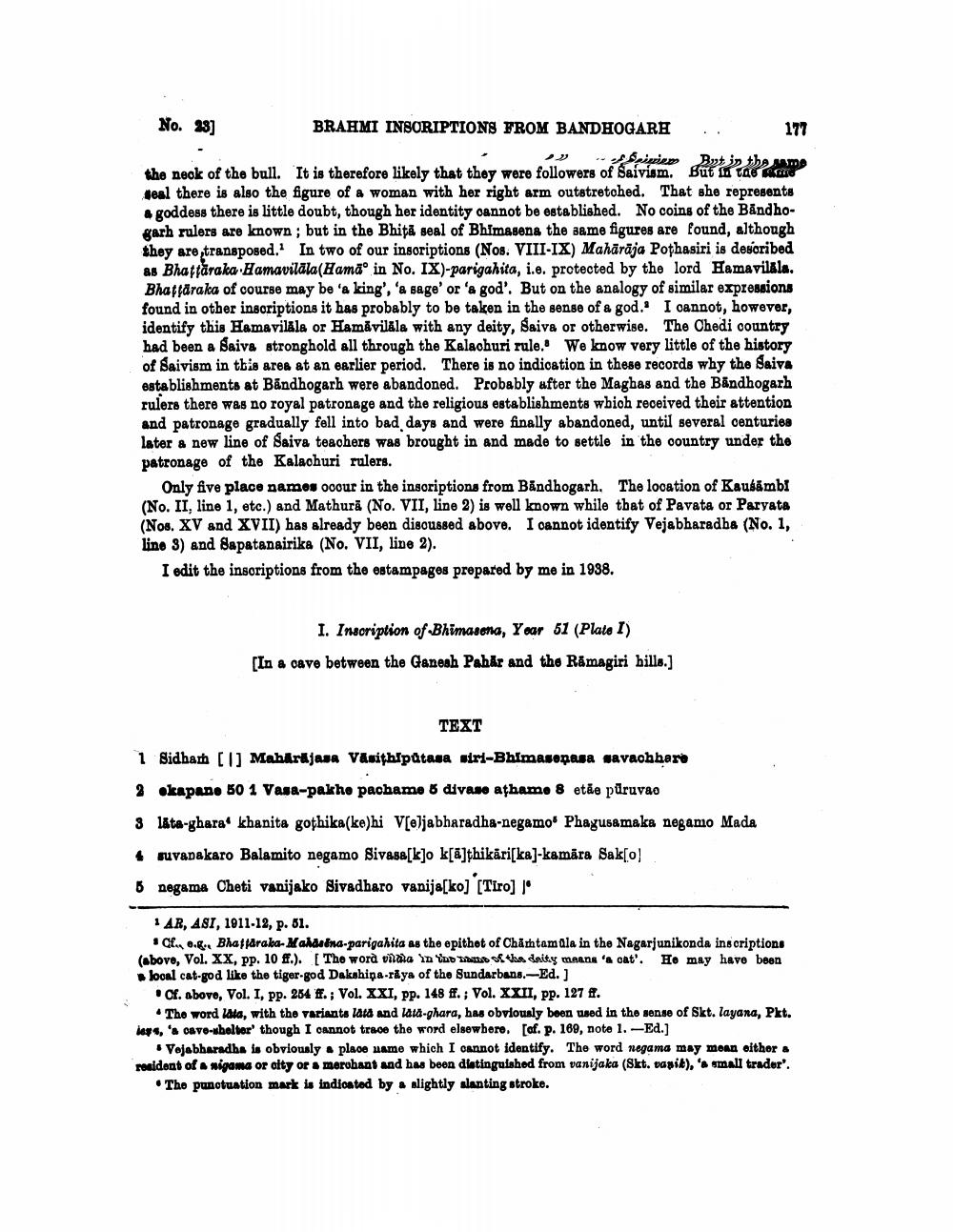________________
No. 38] BRAHMI INSCRIPTIONS FROM BANDHOGARH
177
obrim But in the me the neck of the bull. It is therefore likely that they were followers of Saivism. But I Theme Heal there is also the figure of a woman with her right arm outstretched. That she represents a goddess there is little doubt, though her identity cannot be established. No coins of the Bandhogarh rulers are known; but in the Bhiţă seal of Bhimasena the same figures are found, although they are transposed. In two of our insoriptions (Nos. VIII-IX) Mahārāja Pothasiri is described as Bhatpăraka Hamavilala(Hamão in No. IX)-parigahita, i.e. protected by the lord Hamavilala. Bhaffäraka of course may be 'a king', 'a sage' or 'a god'. But on the analogy of similar expressions found in other inscriptions it has probably to be taken in the sense of a god.' I cannot, however, identify this Hamavilála or Hamāvilala with any deity, Saiva or otherwise. The Chedi country had been a Saiva stronghold all through the Kalachuri rule. We know very little of the history of Saivism in this ares at an earlier period. There is no indioation in these records why the Saiva establishments at Bāndhogarh were abandoned. Probably after the Maghas and the Bandhogarh rulers there was no royal patronage and the religious establishments which received their attention and patronage gradually fell into bad days and were finally abandoned, until several centuries later a new line of Saiva teachers was brought in and made to settle in the oountry under the patronage of the Kalachuri rulers.
Only five place names occur in the inscriptions from Båndhogarh. The location of Kausāmbi (No. II, line 1, etc.) and Mathura (No. VII, line 2) is well known while that of Pavata or Paryata (Nos. XV and XVII) has already been discussed above. I cannot identify Vejabharadba (No. 1, line 3) and Sapatanairika (No. VII, line 2).
I edit the inscriptions from the estampages prepared by me in 1938.
I. Inscription of Bhimasena, Year 51 (Plato I) [In a cave between the Ganesh Pahat and the Råmagiri hills.]
TEXT
1 Sidham [1] Mabar jasa Vanithipatava siri-Bhimasepasa savachbar 2 kapano 50 1 Vasa-pakhe pachame 8 divano atham, 8 etāe pūruvao 3 lata-shara khanita gothika(ke)hi V[eljabharadha-negamos Phagusamaka negamo Mada 4 muvapakaro Balamito negamo Sivasa[k]o k[@]thikari[ka]-kamāra Sak[o! 8 negama Cheti vanijako Sivadharo vanija[ko] [Tiro] I"
AR, ASI, 1911-12, p. 81. 1 ct ... Bhadraka-Maldana-parigahita as the epithet of Chämtamala in the Nagarjunikonda inscriptions (abovo, Vol. XX, pp. 10 ff.). The word väia in tad t o sfthe daisy maana ' oat'. Ho may have been looal cat-god like the tiger.god Dakshina-råya of the Sundarbans.--Ed.)
Cf. abovo, Vol. I, pp. 254 ff.; Vol. XXI, pp. 148 ff.; Vol. XXII, pp. 127 ff.
The word dia, with the varianta lata and lata-ghara, has obviously been used in the sense of Skt. layana, Pkt. laps, 's avo-whelter' though I cannot trace the word elsewhere. [of. p. 169, noto 1. -Ed.]
* Vejabharadha is obviously place name which I cannot identify. The word negama may mean either & resident of a nigama or otty or a merchant and has been distinguished from vanijaka (Skt. vapik), 'a small trader'.
• Tho punotuation mark is indicated by slightly slanting stroke.




